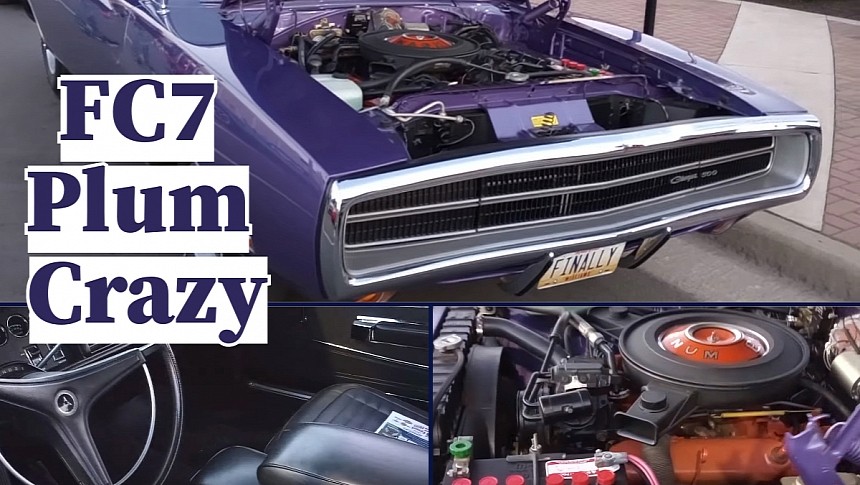Introduced in 1966 as a luxurious fastback aimed at the Rambler Marlin, the Dodge Charger morphed into a fully-fledged muscle car by the end of the decade. The transformation began in 1968 when Dodge rolled out a redesigned version with "coke bottle" styling.
Longer and wider, the revised Charger adopted a sleeker appearance, a high-performance R/T package, and a vinyl top. It wasn't as fancy as its predecessor inside the cabin but looked decidedly more aggressive overall. In 1969, the Charger also joined the ranks of Mopars available with "high-impact" colors.
The second-gen Charger is widely regarded as the coolest and most desirable iteration of the nameplate. It was also quite popular at the time. While Dodge planned to build 35,000 in 1968, demand was high, and the company sold 96,100 examples. In 1969, sales rose even higher at 104,978. Deliveries dropped to almost 50,000 units in 1970 but remained high compared to other B-body platform vehicles.
With around a quarter-million examples produced over three model years, the second-generation Charger is anything but rare overall. However, specific options can turn the muscle car into a rare gem. The 426-cubic-inch (7.0-liter) HEMI V8 engine is the first that comes to mind, but some "high-impact" colors are also rare.
1970 Panther Pink and Green Go cars, for instance, are almost impossible to find. That's because fewer than 0.5% of all Chargers produced that year were specified in these hues. We're talking about fewer than 200 units between them! Sublime, HEMI Orange, and Go Mango aren't exactly common either, with each finding their way on fewer than 3% of production.
Plum Crazy was among the more popular "high-impact" colors. But for some reason, Chargers in this hue are harder to find than Challengers finished in the same FC7-coded paint. Especially if you're looking for a fully restored example, like the 1970 Charger 500 you see here.
Spotted in Auburn, Indiana, this Mopar is one of 27,432 vehicles that left the assembly line with a "badge" and a V8 engine in 1970. But don't let that high number fool you: only 6.4% of them got the vibrant purple color. That's only 1,743 units. It's also one of only 28.2% of Chargers that got a black vinyl interior and part of the 45.5% that were built with a black vinyl roof.
I can't combine all these numbers to get a statistically correct production output, but it's safe to say that fewer than 500 units were built just like this in terms of paint, upholstery, and vinyl top. We can narrow it down even more given the 383-cubic-inch (6.3-liter) V8, one of three engines available in the Charger 500 that year.
But even if you're not obsessed with low-production numbers, this Charger 500 is one of the finest 1970 Plum Crazy examples I've seen in a very long time. It's spotless inside and out, and the engine bay is impressively clean. Check it out in the walkaround below.
The second-gen Charger is widely regarded as the coolest and most desirable iteration of the nameplate. It was also quite popular at the time. While Dodge planned to build 35,000 in 1968, demand was high, and the company sold 96,100 examples. In 1969, sales rose even higher at 104,978. Deliveries dropped to almost 50,000 units in 1970 but remained high compared to other B-body platform vehicles.
With around a quarter-million examples produced over three model years, the second-generation Charger is anything but rare overall. However, specific options can turn the muscle car into a rare gem. The 426-cubic-inch (7.0-liter) HEMI V8 engine is the first that comes to mind, but some "high-impact" colors are also rare.
1970 Panther Pink and Green Go cars, for instance, are almost impossible to find. That's because fewer than 0.5% of all Chargers produced that year were specified in these hues. We're talking about fewer than 200 units between them! Sublime, HEMI Orange, and Go Mango aren't exactly common either, with each finding their way on fewer than 3% of production.
Plum Crazy was among the more popular "high-impact" colors. But for some reason, Chargers in this hue are harder to find than Challengers finished in the same FC7-coded paint. Especially if you're looking for a fully restored example, like the 1970 Charger 500 you see here.
Spotted in Auburn, Indiana, this Mopar is one of 27,432 vehicles that left the assembly line with a "badge" and a V8 engine in 1970. But don't let that high number fool you: only 6.4% of them got the vibrant purple color. That's only 1,743 units. It's also one of only 28.2% of Chargers that got a black vinyl interior and part of the 45.5% that were built with a black vinyl roof.
I can't combine all these numbers to get a statistically correct production output, but it's safe to say that fewer than 500 units were built just like this in terms of paint, upholstery, and vinyl top. We can narrow it down even more given the 383-cubic-inch (6.3-liter) V8, one of three engines available in the Charger 500 that year.
But even if you're not obsessed with low-production numbers, this Charger 500 is one of the finest 1970 Plum Crazy examples I've seen in a very long time. It's spotless inside and out, and the engine bay is impressively clean. Check it out in the walkaround below.








